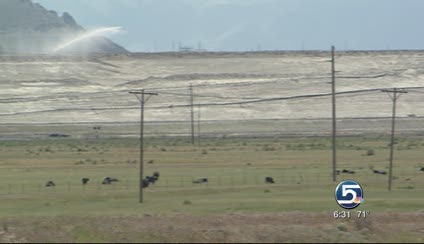Estimated read time: 3-4 minutes
This archived news story is available only for your personal, non-commercial use. Information in the story may be outdated or superseded by additional information. Reading or replaying the story in its archived form does not constitute a republication of the story.
MAGNA — Details of Kennecott's proposed expansion of its north zone tailings impoundment zone will be aired in a series of four public meetings hosted this month by the U.S. Army Corps of Engineers.
The scoping meetings are part of a required public process as the federal agency begins work on a draft environmental impact study slated to be released in April of 2012.
Expansion of the waste rock impoundment is necessary in support of Kennecott's plans to extend the life of its mine through 2039. That expansion is accompanied by the need to obtain a variety of permits from state and federal regulators, a process which includes an analysis of potential impacts to the environment, water quality and air quality.
"This extension -- proposed extension -- would take us about three decades into the future," said Chris Kaiser, Kennecott manager of Environmental Permitting.
The south zone of tailings impoundment by the mine operator has been remediated and closed, with part of that effort resulting in the creation of a 3,670 acre shoreland preserve.
Expansion: 2,000 acres more, 721 of which are wetlands
Current waste rock capacity: Impoundments can take 1 billion tons more
Expansion: Capacity would increase by an additional 1.2 billion tons more, for a total of 2.2 billion tons
Mine would be 1,000 feet wider, 300 feet deeper
Expansion is to sustain average annual production outputs which are:
275,000 tons of copper
400,000 ounces of gold
4 million ounces of silver
25 million tons of molybdenum
This proposal would expand the north zone near Magna several hundred acres to the east and would require the relocation of existing utilities, ditches, secondary roads and a 4-mile section of a railroad line.
The permit before the Corps of Engineers says the project would fill 565 acres of wetlands and 156 acres of nonwetlands water.
Among possible alternatives the federal agency will weigh include rejecting issuance of the permit, accepting the proposal as submitted or a modifying components of the proposed expansion.
"We're confident that, as part of the regulatory review, we'll be held accountable to implement controls that will adequately address the concerns," Kaiser said.
Meetings are set for 6:30 p.m. to 8 p.m., and will include additional information about the project, displays, a chance to meet project representatives and an opportunity to ask questions and provide comments.
The meetings are:
- Tuesday, Webster Community Center, 8952 W. 2700 South, Magna
- Wednesday, Westminster College, 1700 S. 1300 East, Salt Lake City
- June 29 at Hampton Inn & Suites, 3923 W. Center Park Drive, West Jordan
- June 30, Stansbury High School, 4300 N. Aberdeen, Tooele
Over the protest of multiple clean air advocacy groups, the state Air Quality Board voted in May to approve the mine operator's plan to increase the tonnage of rock that can be removed each year as part of its expansion plans.
Although many community leaders have said Kennecott is a good corporate neighbor and critical economic player in the valley, the praise has done little to ease the concerns of multiple watchdog groups that claim any expansion is irresponsible and reckless given the challenges related to the Wasatch Front's air quality.
"Is it really worth displacing other cleaner growth in favor of something that's arguably the dirtiest business that the state will ever see on a grand scale?" said environmental consultant Ivan Weber. "I think it's time we had an adult conversation about that."
Critics of the expansion say it would result in more emissions being released by Kennecott through increased truck traffic and dust from the movement of waste rock.
----
Story written by Amy Joi O'Donoghue with contributions from John Hollenhorst









